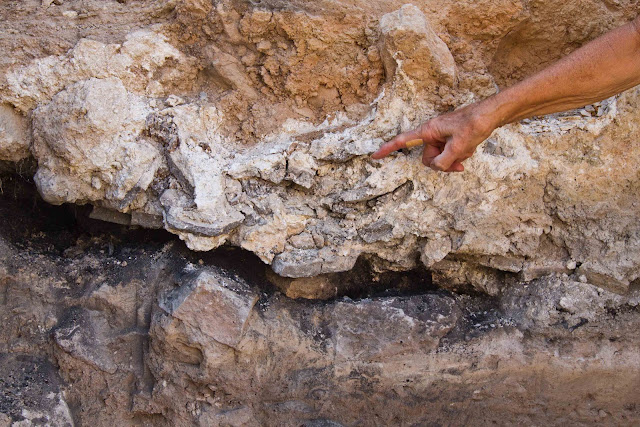August 7 - Tuesday
This will be my last report from the excavation site – I
leave on August 8 to fly home and try to resume whatever it was I was doing
before I began pretending to be an archaeologist. I would like to give my minor contribution to the dig a
context in the bigger picture at Umayri, and to record some overall impressions
about the experience.
Umayri is located on a natural ridge 7 miles south of
Amman, just west of the airport. The
site was occupied by 21 separate settlements, one on top of the other like a layer cake, all dating from the Early Bronze Age
(3000 BC) to the Islamic period. It is
not a strategic site and although there is a perimeter wall there are no
natural or built major defensive fortifications. The site seems to have been chosen for
occupation by these peoples because at the northern base of the hill there was a natural spring
that provided the only reliable source of water between Amman and Madaba about
15 miles to the south. The primary
periods of occupation were the Bronze and Iron ages, and the best preserved
remains are from the transition period between the Late Bronze and Early Iron
Age, around 1200 BC. The built
structures from this period and the artifacts found in them are as good as or
better than at any other comparable archaeological site in the Near East.
It is the goal of the senior archaeological team at
Umayri to continue to excavate the site to reveal as much of the Iron Age I
settlement as possible, learn all they can from their discoveries and then
preserve the exposed built features for posterity. After 14 seasons of excavation, that goal is
near completion. Already a nearly complete Four
Room House and a small temple have been cleared and preserved, along with three
other houses. This season I have been
working with a team on doing the final excavation of the last of those houses,
and we are now almost done. Much of what
has been learned so far from the excavations at Umayri has been well recorded
in an extensive series of scientific publications by the archaeologists. But only a relatively small part of the Tall
has been explored so far and we can only surmise what new discoveries might be unearthed
in the future if the archaeological team is permitted to continue its
excavations. Let us hope that the
secrets of past civilizations interred at Umayri will someday all be revealed.
Participation in this season’s dig at Umayri has been a
rare experience for me. It would never
qualify as a summer vacation, but rather as a rash exercise in unearthing the
unknown. I was not quite prepared for
the heavy physical demands of excavating tons of dirt, rubble and rock, and
quickly concluded that if there is one thing more narcotic to the soul than
lifting and carrying a 50 pound boulder to the rock pile, it is watching
someone else do it. All of that material
had to be literally taken out by hand, and as I thought of myself as a research
assistant to the archaeologists I marveled at how well we treat our research
assistants at Loma Linda. Neither was I
prepared for the heat and the dust. I
come home each day from the dig with my body and clothes adorned with an elaborate
applique of Umayri dust.
Our accommodation was adequate but Spartan, not receiving
even a one star rating. If I had broken
a leg on this trip it would not have been because I fell off a balk but because
I had slipped on the very slick tiled floor in the bathroom. I had to adjust to the strange work schedule
with the wake-up bell sounding at 4.15 every morning. That restorative feeling of a good night’s
rest vanishes with astonishing swiftness when you quickly realize that
breakfast is at 4.30.
But all the minor irritations, tired muscles and aching
joints were insignificant compared to the excitement on the dig. When an interesting new “find” was displayed I
could not match the effervescent exuberance of the archaeologists, but it is
still an exciting experience. Besides
sharing in the joy of new discoveries, I really enjoyed learning a little about
the procedures and the processes used in conducting an excavation at a historic
site such as this. So this experience
has been an intellectual and emotional stimulus, not mind-bending but
remarkable, one that has expanded my horizon, out of my comfort zone, and
introduced me to a completely new world.
And then there has been the extraordinary experience of
getting to know some Jordanians and traveling around and seeing the sites in
this interesting country. The people are
most friendly and hospitable and it has been almost a humorous challenge to try
to communicate with our Bedouin workers.
I have acquired a few words of Arabic – mahaba (hi), salam elecum
(hello), masalama (goodbye), shukran (thank you), hef halek (how are you), mufi
mushkala (no problem) and habibi (sweetheart) although I have not had much use
for that last one. But one of the real
treats about joining the team this season has been the opportunity to travel
with my enthusiastic colleagues and enjoy some of the incredible historic sights in Jordan.
Dr Clark attracts a large following of students who are
interested in taking this hands-on excavation experience for university credit,
but he is also interested in having volunteers like me join his team. Actually I have pointed out that I am also
getting credit for my experience here – from my grandkids who are giving me
credit for being such a cool grandfather.
So – masalama Umayri.
Moonrise over Tall al-Umayri

















